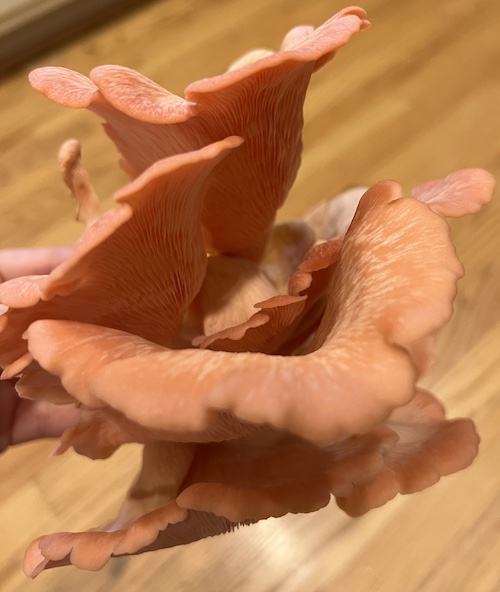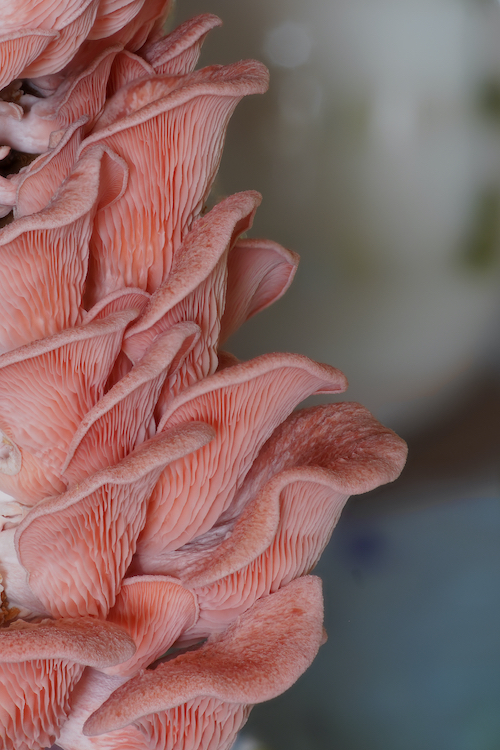Pink Oyster
Pleurotus djamor
Introduction:
The Pink Oyster Mushroom, scientifically known as Pleurotus djamor, is a visually striking and economically significant fungus that belongs to the Pleurotaceae family. Widely recognized for its vibrant pink coloration, this mushroom has garnered attention not only for its aesthetic appeal but also for its culinary uses and potential health benefits. Let's explore the Pink Oyster Mushroom, to learn more about its biology, ecology, and cultivation.

Biology:
Taxonomy:
Pleurotus djamor is a member of the Pleurotus genus, a group of mushrooms known for their oyster-shaped caps and versatile growth on various substrates. The species name "djamor" reflects its origin and was first described from specimens collected in Djibouti, East Africa.
Morphology:
The Pink Oyster Mushroom is characterized by its vibrant pink to reddish-pink cap, which ranges from 5 to 15 centimeters in diameter. The cap has a convex shape when young, gradually flattening out as it matures. The gills underneath are closely spaced, and the stem is eccentrically attached to the cap. The entire mushroom has a soft and delicate texture.
Ecology:

Habitat:
Pink Oyster Mushrooms are saprotrophic, meaning they obtain nutrients by decomposing dead or decaying organic matter. In the wild, they are often found growing on hardwoods, dead trees, logs, or other organic substrates. Their ecological role involves breaking down complex organic compounds, contributing to nutrient cycling in forest ecosystems.
Distribution:
While Pleurotus djamor has its origins in East Africa, it has been widely cultivated and adapted to various climates around the world. Its ability to thrive in different environmental conditions has made it a popular choice for cultivation globally.
Cultivation:
Substrate:
Pink Oyster Mushrooms can be cultivated on a range of substrates, including agricultural by-products like straw, as well as on hardwood sawdust or supplemented substrates. They are known for their adaptability and can be cultivated using both indoor and outdoor methods.
Cultivation Process:
- Substrate Preparation: Prepare and sterilize the chosen substrate to create a suitable environment for mushroom growth.
- Inoculation: Introduce the mushroom spawn to the substrate, allowing the mycelium to colonize.
- Incubation: Provide the right conditions for the mycelium to spread and fully colonize the substrate.
- Fruiting Conditions: Create an environment with proper humidity, fresh air exchange, and light to induce fruiting.
- Harvesting: Harvest the Pink Oyster Mushrooms when the caps are fully developed but before the gills start to turn dark.
Culinary Uses:
Known for their mild, anise-like flavor and vibrant color, Pink Oyster Mushrooms are popular in various culinary applications. They can be sautéed, stir-fried, grilled, or used in soups and salads. Their unique appearance adds a colorful and appetizing element to a range of dishes.
Health Benefits:
Pink Oyster Mushrooms are not only appreciated for their culinary attributes but also for potential health benefits. They are a good source of protein, fiber, and essential nutrients, and some studies suggest they may have antioxidant and immune-boosting properties.
Conclusion:
The Pink Oyster Mushroom, Pleurotus djamor, stands out as a visually stunning and versatile fungus with ecological, culinary, and potential health benefits. Whether flourishing in natural ecosystems or cultivated for human consumption, this mushroom continues to captivate enthusiasts and researchers alike, contributing to our understanding of fungi's multifaceted roles in nature and agriculture. As cultivation practices advance, the Pink Oyster Mushroom remains a fascinating subject for exploration and appreciation.